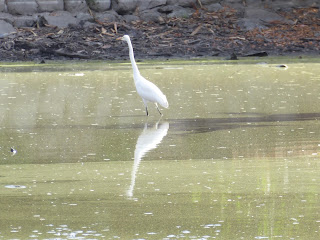The human population on this planet continues to grow, and resources continue to become increasingly limited. I wonder how long it can continue. But a resource such as water can make or break a population's ability to survive, or at least inhabit a place. Lack of it can lead to civil unrest and armed conflict.
I have continued to question the wisdom of lawns in the landscape, especially where water is limited in supply and grass is not native. I believe it is wiser to incorporate native plants that can accomplish some, if not all of the objectives that turf grass does: cover the ground, provide an aesthetically pleasing area, provide a contrast to surrounding plants. Whereas the objective of being able to tread upon it may not be met, there is an added benefit of other groundcovers that turf does not provide: habitat and food for wildlife - specifically pollinators.
There are many plants that can meet these objectives. Some of them can be invasive, such as English Ivy (Hedera helix) or wintercreeper (Euonymus fortunei). So one must use care when selecting these plants.
Another benefit of native groundcovers is that many will provide seasonal color, whether in leaf or flower, as well as interesting foliage.
Some people in drought-stricken areas, may choose to remove plants altogether. But many will not find this option visually pleasing, and miss the many benefits that plants provide.
When I used to teach landscape design classes, I would talk about xeriscaping to my students. Xeric plants are those which can withstand arid conditions. But some students made a joke out of the term, and called it zero-scaping. In a recent walk around a Los angeles neighborhood, I saw two plantings very near each other that illustrate a xeriscape and a zero-scape:
 |
| Recently-planted drought-tolerant plants |
 |
| Drought tolerant plants |
 |
| Zero-scape |






























